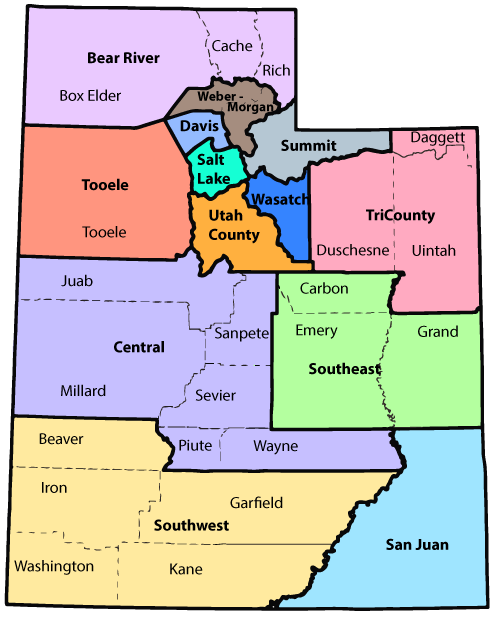Local Public Health Systems
At the local level, public health services in Utah are organized into 13 health districts.
Seven of the 13 local health departments are single county and six are multi-county
districts. The San Juan health department was formed in 2015.
The local health districts in Utah include the following:
Local health departments provide many essential health services. They are often the front line for reporting communicable diseases and other events, such as signs and symptoms of exposure to biologic agents of terrorism. Their work ensures that communities have clean air to breathe, safe food to eat, and water to drink. Local health departments also provide health education and prevention services such as immunizations and preventive health screenings.
The highest priority health problems vary among local districts, especially between the more urbanized Wasatch Front districts and the more rural districts.
Public health capacity in Utah is provided by both state and local public health entities, as well as community health centers and community based organizations. The private health care system, including hospitals, physicians, health plans, schools, and private-non-profit agencies, deliver many important local public health services as well.
For more information about local public health in Utah, see the Utah Association of Local Health Departments website at www.ualhd.org.

The local health districts in Utah include the following:
- Bear River (Box Elder, Cache, Rich counties)
- Central Utah (Juab, Millard, Piute, Sevier, Wayne, Sanpete counties)
- Davis County
- Salt Lake County
- San Juan County
- Southeast Utah (Carbon, Emery, Grand counties)
- Southwest Utah (Beaver, Garfield, Iron, Kane, Washington counties)
- Summit County
- Tooele County
- TriCounty (Daggett, Duchesne, Uintah counties)
- Utah County
- Wasatch County
- Weber-Morgan
Local health departments provide many essential health services. They are often the front line for reporting communicable diseases and other events, such as signs and symptoms of exposure to biologic agents of terrorism. Their work ensures that communities have clean air to breathe, safe food to eat, and water to drink. Local health departments also provide health education and prevention services such as immunizations and preventive health screenings.
The highest priority health problems vary among local districts, especially between the more urbanized Wasatch Front districts and the more rural districts.
Public health capacity in Utah is provided by both state and local public health entities, as well as community health centers and community based organizations. The private health care system, including hospitals, physicians, health plans, schools, and private-non-profit agencies, deliver many important local public health services as well.
For more information about local public health in Utah, see the Utah Association of Local Health Departments website at www.ualhd.org.
Map of Utah 13 Local Health Districts

Content updated: January 2022
